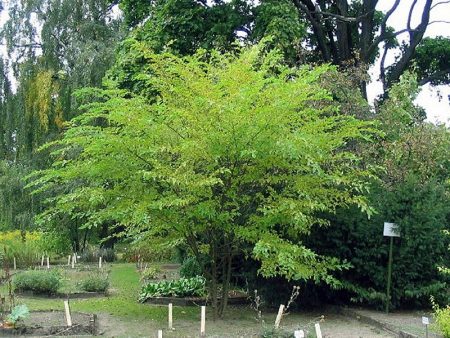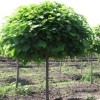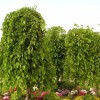Mulberry or mulberry tree: main varieties
Content
Varieties
The classification of mulberries is quite extensive and ambiguous. The genus Mulberry has about 200 species of plants, only 17 of which are generally recognized and cultivated in different parts of the world. The rest of the species are represented by fruit, forage and ornamental hybrids that do not have a clear classification.
Of the whole variety of forms and types, three main ones are distinguished, depending on the color of the fruit: black, white and red mulberries, which, in turn, are subdivided into varieties.
Black and white mulberries are considered the most common. They are planted everywhere: in India, Afghanistan, Portugal, Spain, including in the south and in the regions of central Russia. White mulberry came to us from eastern China, where it has been grown for more than 3 thousand years as food for the silkworm. From China, the plant migrated to Central Asia, and then to the Transcaucasus. Mulberry came to Europe around the 12th century, and to Russia - in the 17th century, but not in all territories the climate was suitable for its cultivation, so the culture moved to the regions of the Caucasus and the Volga region.
White mulberry, in comparison with other species, is low (13-18 m). Its crown is compact, spherical, but sometimes spreading. The trunk and main branches have a light grayish-brown color, thanks to which this variety got the name "white", since its fruits are not only light, but also pink, yellow, and even black. White mulberries are considered the sweetest - they contain from 12 to 23% of sugars. These trees have a very decorative appearance - multi-colored stems in combination with various forms of foliage make it possible to use plants in landscape gardening.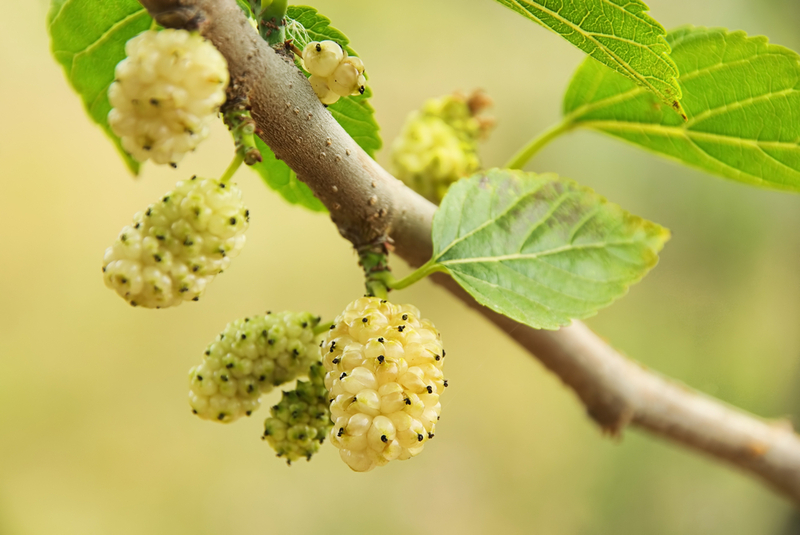
The red mulberry is native to eastern America. The trees are low (10-15 m) with large (up to 14 cm) heart-shaped foliage and a dense voluminous crown. The bark of the trunk and large branches is brown, rough. The fruit is a purple drupe 2-3 cm long, looking like a slightly unripe blackberry. It is quite sweet (up to 11% sugar), and, in comparison with white and black berries, can be stored longer. In terms of frost resistance, red mulberry is superior to white, but it is not so common in gardens.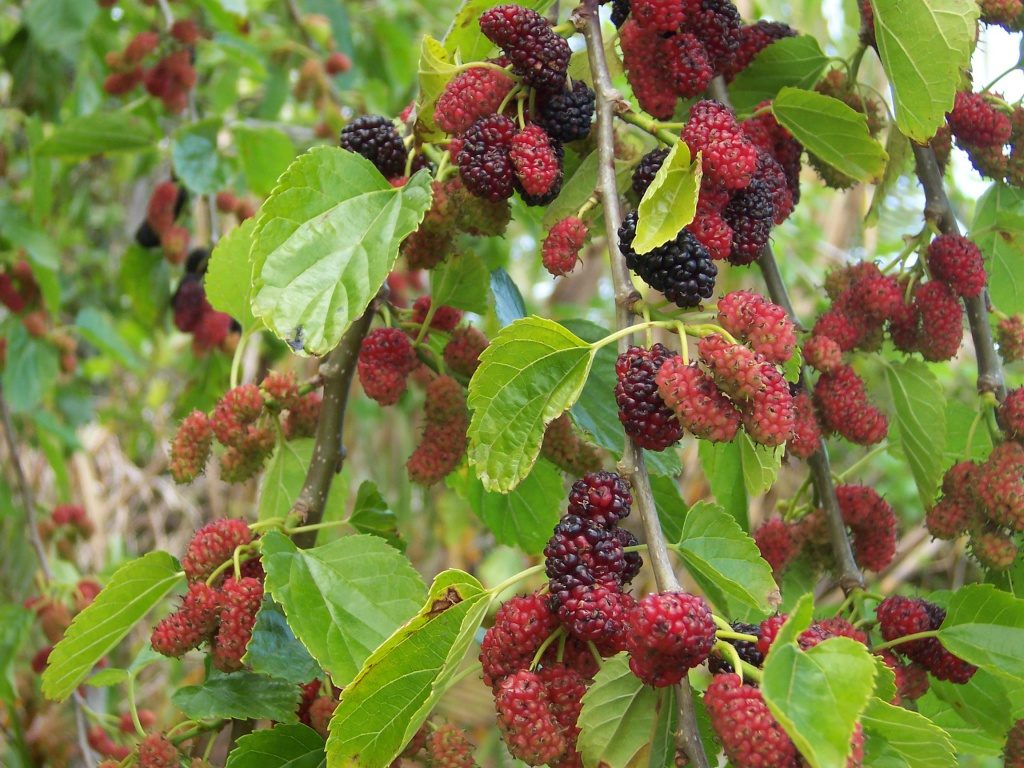
The homeland of black mulberry is Central Asia (Iran and Afghanistan). The trees of this variety are tall, with a spreading crown and large ovoid or heart-shaped dark green leaves. The bark of the trunk is dark, brown in color. The berry is black or dark blue, large in size (2-5 cm), very juicy, sweet and sour taste. Trees are undemanding to the soil, they tolerate heat and drought well, but they are thermophilic, so they will have a big return in the southern regions.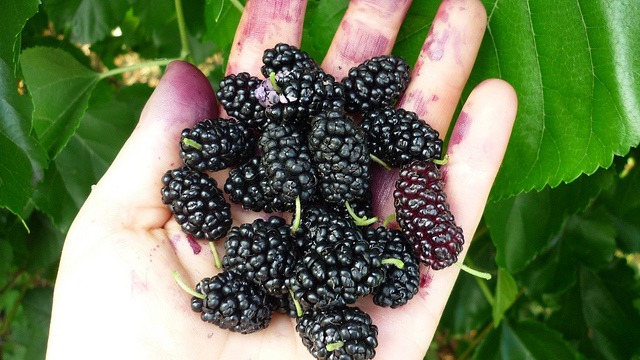
Almost all types of mulberry are dioecious plants (male and female flowers are located on different trees), therefore, for pollination, it is necessary to plant two trees side by side, however, self-fertile mulberry is also found, pollination of which occurs mainly with the help of the wind. The culture grows very quickly and is easily grafted - several varieties can grow on one tree at the same time, with different color of seedlings. Mulberry trees are long-lived - their lifespan can range from 150 to 500 years.
Video "Features of growing mulberry"
From the video you will learn how to properly grow mulberries.
White varieties
As you know, white mulberries can have different colors of seed fruits, but to make it easier for a common man to figure out which variety of berries have exactly a light color, a list of the most basic white-fruited varieties is offered:
- White honey. A very popular hybrid of domestic breeding in amateur gardening, obtained by free pollination of the best samples of white mulberry. The tree is medium in size, the crown is dense, pyramidal. Compound fruits are elongated white drupes 3 cm long with a sweet honey taste. Fruiting is regular, the yield is high. Trees are frost-resistant (withstand up to -30 ° C), after frost they quickly recover. The berries are very tender, so they are poorly transported and stored.

- White tenderness. A frost-resistant variety with high productivity. Fruiting begins in early June and lasts for 2 months. The fruit is pure white in color, long, sweet in taste, however, in rainy weather, the taste deteriorates (becomes neutral).
- Smolensk pink mulberry. New early (early July) variety for home gardening. The plant is unpretentious, frost-resistant, begins to bear fruit in the first year of planting. Compound fruits are small (2-3 cm), pinkish or red, very sweet. Due to the special shape of the leaves and multi-colored fruit, the culture is often used as a decorative element of the garden.
- Fruit-1. An early ripe (June) variety with white stems, which tend to turn pink in rainy weather. The berries are large (3 cm), sweet taste with a slight sourness. The yield is high, the fruiting period is long. The berries are juicy, but quite dense, they can be transported.
- Ukrainian-107. Mid-season (July) hybrid with light pink, large (2.5-3 cm) seedlings. Dessert taste, sweet, transportable fruits. The resistance of trees to frost and disease is high. Fruiting is abundant, begins at the age of 3. The yield from an adult tree is 15-17 kg.
- Merezhevo. A hybrid obtained by grafting a white mulberry. Mid-season (first decade of July), fruiting lasts 1 month. Compound fruits are pinkish-creamy, large in size, sugary sweet taste, easily crumble from the tree, not stored for long.
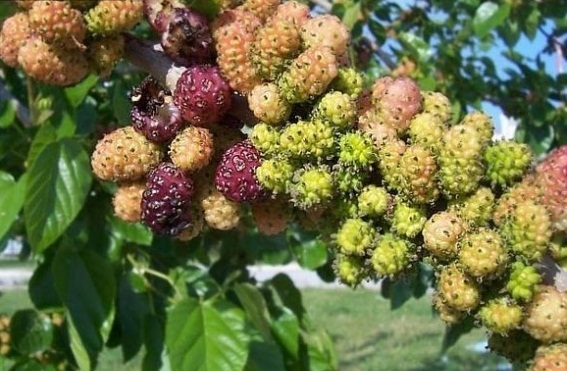
Black varieties
And here everything is ambiguous - many varieties with dark (black berries) belong to white mulberries, but in order to avoid confusion, in this section varieties will be presented whose seed fruits have a black color characteristic of the description:
- Fruit-4. A productive black-fruited variety with rather large (up to 4 cm) berries. The plant is compact, low (up to 5 m). Fruiting is regular, abundant, extended, the total yield is very high. The variety is frost-resistant, suitable for commercial cultivation. Fruit fruit has a sweet refreshing taste, dense, well transported.
- Black Baroness (white mulberry). Domestic variety obtained from free pollination. Compound fruits are large (3.5-4 cm), rich black color, dessert taste, with a light sweetish aroma. The variety is frost-resistant (does not freeze at -30 ° C), mid-season (ripens in early July), unpretentious to conditions. The yield is high - an adult, large plant is capable of producing up to 100 kg of berries per season. Transportability is average, the shelf life of berries is up to 12 hours.
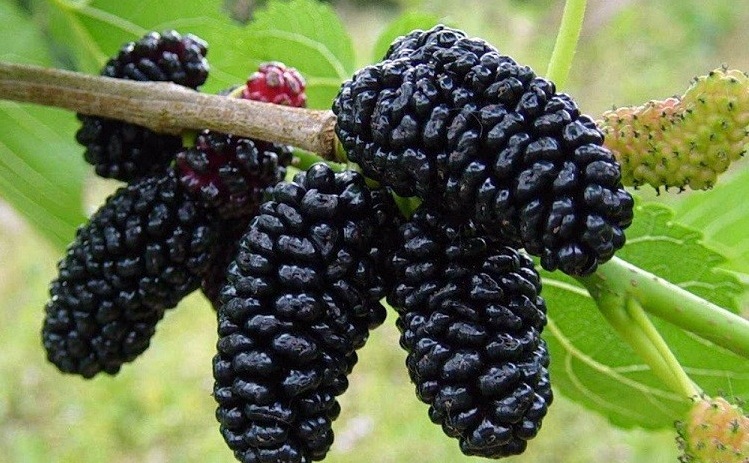
- The dark-haired woman (refers to the white mulberry). Self-fertile hybrid obtained from pollination of the white variety. The trees are large, with a dense spreading crown. Compound fruits are one-dimensional, cylindrical, large (3.5-4 cm), black in color, taste sweet and sour. Regular fruiting, high yield. The variety is frost-resistant, recovers quickly. The berries are transportable, stored for 12-18 hours.
- Ukrainian-6. A universal variety created at the Ukrainian Research Institute - it gives delicious berries, can be used for feeding a silkworm, as well as for decorative purposes.Compound fruits are long, large (up to 4 cm), black, matte in color and sweet dessert taste. Fruiting profuse, earlier (early June). High frost resistance (withstands up to -30 ° C). The transportability of the berries is good, storage is more than 12 hours.
Large varieties
Large-fruited varieties are considered to be producing infertility of at least 4-5 cm. These include:
- Mulberry Istanbul. Highly productive frost-resistant variety with large (up to 5 cm) dark purple seedlings. Ripening period is late (late July - early August), abundant fruiting, starts from 4 years old.
- Shelley mulberry. An early (end of June) large-fruited variety with decorative large leaves and equally attractive fruits. The mulberry of this variety is considered one of the largest - the size of its seed fruits reaches 5-5.5 cm. The berries are elongated, black, glossy, sweet dessert taste, dense, can be transported.
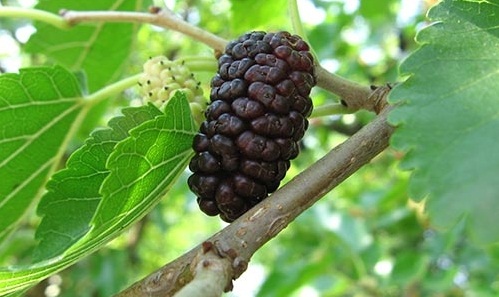
- Mulberry Galicia 1. Universal hybrid of Ukrainian selection. Compound fruits are very large (6-8 cm), oblong, black or dark purple in color (outwardly similar to blackberries), sweet, refreshing taste, with a light berry aroma. The yield is high - up to 40 kg from a 5-7 year old tree.
- Mulberry Black Prince. Unpretentious, disease-resistant, drought and frost-resistant variety. Fruits are large (4-5 cm), glossy, intense black color, sweet honey taste. Despite their juiciness, the berries are well transported and stored.
- Mulberry Hartut. An ideal variety for making wine - the juice of this mulberry is sweet and thick, like quality Cahors. The fruits are rather large (4-5.5 cm), black, contain 18-20% sugars, are recommended for winemaking, jam, as a dessert. The variety is self-fertile, fruiting begins at the age of 3 years, the yield is stable and high.
Decorative varieties
Of all the many varieties and varieties of mulberry, most are decorative species that have long been successfully grown by gardeners for use in landscape design. The basis for the breeding of most of the decorative varieties was the white mulberry - it is its varieties that are distinguished by the variety of shapes and colors of the leaves, the original crown.
The decorative mulberry can be used as a single plant or to create hedges. It tolerates pruning, haircuts and is weather-resistant.
These trees have many unusual and spectacular shapes, which are widely used to decorate landscape space:
- spherical mulberry - a small tree with a compact spherical crown;
- weeping - with drooping, like a willow, branches and small unusual leaves;
- pyramidal - with a narrow pyramidal crown, consisting of lobed leaves;
- large-leaved - a rare standard variety with large (22-24 cm) leaves of a light green color;
- Tatar - undersized, slow-growing shrub with small leaves;
- golden - a small tree with really golden young shoots that become darker with age.
To decorate the premises, a remontant variety is used - it is a dwarf, very compact mulberry that can be grown in a pot or container. You can also decorate the garden with universal varieties that are highly decorative, and at the same time give very tasty berries. These include: Smolensk pink, which has already been mentioned, or Red felt - a beautiful tree with reddish top and bottom white leaves and delicious purple seedlings. This solution is most successful for a small private garden, as it allows you not only to enjoy the amazing taste of berries, but also to divide or decorate the landscape space.
Video "Features of a mulberry tree"
From the video you will learn what a mulberry tree is.

